 |
Let's Prehend A Manual of Human Ecology and Culture Design |
Chapter 2: PROCESS MODEL, A Simple Theory of Complex Systems
"Let me make everything perfectly clear." —Richard Nixon
Let's consider a new PROCESS MODEL, keeping it as close to the models of science as possible, but easier to understand and share.
Here's the dilemma: we try to imagine reality as a process not made of words, yet we describe it with words. Let's alleviate this problem by using a more visual and quantitative approach. We'll use analytical charts to augment verbal descriptions. It may be a bit awkward at first, but time breeds familiarity. The pay-off is a new frame of reference to assist understanding and sharing.
Unlike traditional science, this new PROCESS MODEL tries to describe everything, obliged to consider all problems, necessarily at the expense of the stricter scientific criteria. We sacrifice, or postpone, validity and agreement for the sake of this need to be all inclusive. The model bites off more than can be chewed, but it's only a tool for analysis and discussion, not a belief or truth.
Let's accept the dilemmas of mind - false-focus, FF, and there and then, TT, as described in Chapter 1, REALITY AND SCIENCE. With these corrections in mind, let's take a fresh look at our intellectual traditions.
Process
Reality is not made of words, or green cheese; it's made of processes. But there-and-then, TT, causes process to stop. Also, false-focus, FF, turns processes into things - call it "thingism". Although we can alleviate thingism with our new PROCESS MODEL, we can't avoid it. The problem is inherent in the nature of mind as an information processing machine.
The fight between fixity and flux is an ancient one. Philosophers through the ages have asserted that reality is a process. As metascientists, we could simply accept this generalization and proceed with the theory. But as objectivists we must ask how and why the mind tends to fixate processes into things. At each step we are obliged to ask not only how reality works, but how the mind works to miss-perceive and distort reality's process. This is especially crucial and difficult, even embarrassing, in the social sciences.
Electron Soup
Scientists explain most of our subjective experience as electron processes. Objective explanations describe the atoms that make up our physical world as globs of electrons shielding a tiny, heavy nucleus at their core. It's electron bonding that holds things together, makes them hard or soft, liquid or solid. This electron theory with its electromagnetic theory, also explains color, light and heat. The shift of electrons from one atom to another explains burning and growing, all the chemical changes of life, perhaps even our consciousness itself. Ask any child fresh from science class for the latest theories.
In the objective view, the electron is not a 'thing' with properties, it is the focus of forces. Our image of an electron as a little charged ball may be a convenient beginning, but it's only a mental construct, a distortion necessitated by our mind's FF and TT. Fortunately our mental images grow and develop. As objectivists we don't need to 'believe' one theory or another. We only need to improve our model of the electron as theories evolve.
One of the electron's processes is called the electrostatic force. This force decreases with the square of the distance but extends infinitely, like gravity. Therefore, imagining an electron as this process, each electron fills the universe, all electrons overlap, and reality is one vast electron soup.
This objectivist image is very different from the subjective reality of common experience, yet it is valid from the view of physics. Because it's hard to imagine reality as electron soup is no reason to deny it's objective validity. As objectivists, we are obliged to accept this inevitable Dissociation of Ideas from Personal Life, DIPL. Some physicists may actually experience reality this way, but only their spouses know for sure.
The images from 'electron soup' are closer to reality than more subjective images because they describe what is happening more accurately and completely. For example, if one wiggles an electron, this wiggle propagates outward and fills the universe, like a ripple in a giant jello. This makes radio communication possible throughout the universe. We received information from space probe Voyager at the edge of the solar system. Radio telescopes gather information from the beginning of the universe, including CBR ripples from the forming firmament.
Similarly, every process in one's brain overlaps every other brain and fills the entire universe, possibly a mechanism of mysticism. This Mechanism of Mysticism can be abbreviated MM, pronounced "mmmm". A recent study indicates that when two people are in communication, their electro-encephalographs, EEGs, tend to resemble each other in some relevant ways.
But don't worry, human consciousness is designed to ignore all this. The conscious mind struggles to disregard and deny this excess information from the universe, even from loved ones. Hypersensitivity to such myriad input is considered a pathology, especially in our culture, and is treated with specific drugs to turn it off, as in Chapter 3 and DRUGS.
Total Process, TP, is another term for the whole of reality, emphasizing the interrelatedness of everything. TP covers everything. TP connotes the complexity of the total system and all the subsystems of reality, including you and me.
What a relief it is to keep a scientific attitude: there is no absolute, no truth, no burden of certainty. These far-out scientific images allow new freedom to understand and experience. Perhaps this sense of relief comes from a release from adversarial thinking. Objectivists do not reject, deny or disparage, but rather, in the best scientific tradition, try to embrace, develop and share objective theory.
Intensity, i
Let's look at processes themselves, which we sometimes call "things". What makes a thing? How is any particular thing differentiated from its environment, from the entire electron soup of our universe?
Our subjective consciousness perceives trees as things, but objectively and physically they are infinite. From the narrow viewpoint of subjective perception, light bounces off the bark and leaves, and that's a tree thing.
Objectively, what is a tree? If every tree fills the universe, where is the border of an individual tree? In this objectivist model, we define objects by some quantity of a particular process, not by any quality. For example, a tree can be described (not 'defined') in many ways - by the edge of its bark, by its place in the lumber market, by its production of oxygen, by its aesthetic unity within the landscape, its exchange of electromagnetic radiation affecting the green-house-effect, its appearance to extra-terrestrial intelligences.
Imagine the tree as an organ or 'sub-process' of a forest ecosystem - as an energy transition device from the nuclear reactions in the sun to the production of wood and oxygen. Imagine the total process, and the broader infinite function of tree. Survey these imaginings until the tree loses its limits and becomes the focus of processes which fill the universe. Every tree fills the universe. The RIDly need for understanding and certainty is lost.
In this electron soup image, we see that one subprocess distinguishes itself from another only by its particular intensity, i. The edge or surface or border of an object is a decrease in the relationship, i, between its atoms (subsystems) and the other atoms of the universe. The bark is more intensely related to the tree than to the air.
Imagine that there are no 'things', only an infinite mush, fuzz or chaos. 'Things' appear solely by distinguishing some particular i quantity of a relationship.
Your finger, for example, is more closely related to your hand than to mine. Objectively, a finger fills the universe and can only be singled out by specifying its i, the borders of whichever of its processes concern us.
If you painfully cut your finger, I will certainly be strongly affected. Gee, Gordon Liddy, please don't. (Radio talk show host Mr. G. Gordon *Liddy was convicted as a participant in the famous Watergate break-in, during President Nixon's administration to gain information. In his formative years, Mr. Liddy is said to have deliberately burned his hand over a candle in order to strengthen the dissociation of body from mind, of feelings from ego. According to his autobiography and its movie version, he was trying to impress a young lady, and failed.)
There are infinite other relationships involving your finger. The i amount of process between your finger and the moons of Jupiter is very low and of little concern, but it is not to be denied. For example, putting your finger on the controls of the Voyager space probe as it neared the moons of Jupiter can have important consequences. Imagine it as an increase of the i information or integration between you and Voyager.
Reductionism
One might argue that the transmitter is tuned to the receiver in the satellite, then comfortably ignore or even deny that infinite other relationships exist. Such an argument illustrates Compulsive Reductionism, CR, a denial of everything else that's going on. What is 'tuning' but the increase of a particular relationship, i, so that the receiver of this satellite responds, but not the other rockets or rocks in space? This is a quantitative, not a qualitative difference: the high i process of this transmitter and receiver is differentiated from the infinitude of other systems only by particular levels of intensity, i, the tuning.
This new way of defining objects only at a particular level of i is admittedly awkward, but it's essential if we are to alleviate the mind's distortion that limits processes to the "thing in itself", Ding an sich. There is no such thing-in-itself, because every thing fills the universe. Things become defined only when a particular i measure boundary is specified, or implied. This DIM demand to define and make perfectly clear is essential to our minds, perhaps, but not to reality.
The parameter, i, is a gross measure of the amount of process, the amount of integration. ( Apologies for this term "parameter", but it's important to stress the quantitative image, as the scientists do. A parameter is the way one measures something. The parameter of a perimeter is often in linear feet or meters.) This i reminds one of the "chi" energy of oriental medicine, the "elan vital" vital impulse of philosopher Bergson, and other examples from every culture. One biophysicist who is also a 'new age thinker', Beverly *Rubik uses the term 'information'. In discussing alternative medical therapies, she suggests science is entering an 'information age', not just in the sense of new communications but in the sense of acknowledging these complex processes. She cites physicist David *Bohm's term "active information", data "potentially active everywhere but active only where meaning is drawn."
Intensity, i, is how we distinguish one process or thing from another. With complex systems, this parameter, i, is more difficult to label and to measure. For example, with biological systems, i can refer not only to the simple attractive forces between molecules, but to many more subtle relationships. But i is not a word, it is a quantity, the amount of relationship, the basic measure of organization, the amount of "prehension". The term "prehend" refers to the basic integrative process in the metaphysics of Alfred North *Whitehead, the English philosopher, 1861-1947, who wrote *PROCESS AND REALITY, SCIENCE AND THE MODERN WORLD, etc., and, with Bertrand *Russell, *PRINCIPIA MATHEMATICA.The term, i, can describe the amount of information, integration or some other relationship. For example, a jellyfish on the beach is much softer than the sand: its i, as simple electrostatic crystalline hardness, is much less than that of a grain of sand. To give the starfish its due we must look at a more relevant i, such as the complex physiological processes that hold it together for its short life. Let's call it "integration" or "information", but keep as close as possible to the rich images of the physiologist. If we are studying it from this broader viewpoint, the jellyfish has more i than the grain of sand. But if we are using the sand to make concrete to pave over the beach, the simple hardness of the sand may be more important. Such is the problem of the compulsion of the abstract mind: whether to acknowledge the value of the jellyfish in its ecosystem, or pave the beach for a resort parking lot.
Extent, E
E, extent, is the second parameter. E measures the number of subsystems that make up a system, such as the number of grains of sand on the beach, or the number of people in a city. E is the size of the system, but only as defined at a particular level of i. Thus, E, represents the number of grains of sand, defined only at this particular intensity, i, the edge of each grain.
Summarizing Systems
The words 'process', 'organism', 'system', and even 'thing' are almost interchangeable. 'Process' asserts the dynamic of reality, particularly to avoid the fixation of the mind's FF and TT. 'Organism' stresses the complexity, a difficult idea to define but intuitively obvious, even to a non-biologist. 'System' connotes the complication of many subsystems and super-systems, which defy and challenge the imagination. 'Thing' is used in its common meaning, but with tolerant recognition that no thing is really a thing-in-itself, but that the mind makes it so. This basic distortion can be alleviated, but we can never "make things perfectly clear". No theory can be true, only descriptive, useful, perhaps appealing, even aesthetic if not too frightening.
In summary: We propose a process model and the image of electron soup. Our PROCESS MODEL analysis of reality has just two parameters, E and i, not three or four. Perhaps we choose two because paper has two dimensions. That is reason enough, for the present, because theory is a tool not a truth. Let's explain the differentiation of things, E, by their intensity or integration, i. Reality is not made of words, and neither is this model. We use words to refer to and describe these images, not to define them.
Even an ordinary duck cannot be defined, but only described. No matter how precise and elaborate, no set of words or pictures can do justice to this dear animal. [DUCK]
Let's create two charts as tools to analyze and diagnose complex systems. To introduce these two charts, we will begin with images from the natural sciences because they are comparatively simple, just as physics is simpler than sociology. Once we become familiar with the basic charts, we will proceed in subsequent chapters to expand our scope. Our analysis will expand from sand to people, from beaches to societies, from oceans to economies, and so on, as we apply the charts to the evaluation and diagnosis of more complex and more interesting systems.
Evaluation Charts, E Charts
Consider a chart of living organisms:
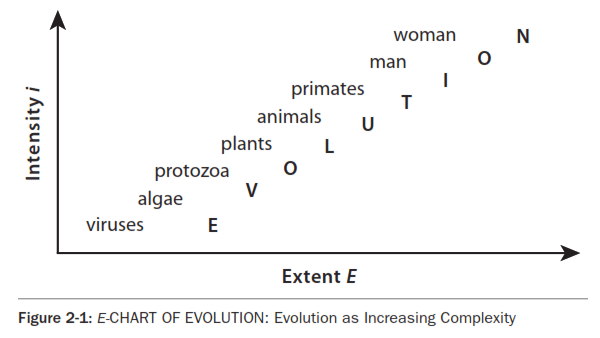
This chart refers to the comparative complexity of living organisms. (For further explanation of complexity see Murray *Gell-Mann's THE *QUARK AND THE JAGUAR. and also the periodical *JOURNAL OF COMPLEXITY.) Notice that i refers to integration, perhaps measures of life process such as the exchange of nutrients, messenger molecules or nerve impulses. E refers to the number of subsystems such as cells.
Notice that this E chart does not describe evolution in time, but rather compares the evolving complexity of life. with branching chains showing diversification and extinction as found in basic biology texts. It focuses on evolution by simply using to illustrate increasing complexity. The reader might elaborate the chart by adding whales and pink elephants, dogs and cats, pigs and sheep, just to get the hang of it. Recent DNA research sheds new light on evolution, changing and developing older images.
For example, notice that protozoa and algae, meant to be almost in the same spot, have the E of one cell at the i that defines the cell, their cell wall. The more complex animals and plants have higher E (to the right) of many cells, but also added i (upwards) of the integration of cells into tissues. Increasing complexity is represented by a move upward on the i scale, usually combined with a move to the right on the E scale.
Complexity
The complexity of living systems might be represented by the amount of DNA information, the size of the double helix molecule in the gene that carries the information of its life. Not so simple: horses have several times more DNA than humans. The Houyhnhnms Jonathan *Swift's *GULLIVER'S TRAVELS are horses, described as "a race of intelligent horses who are served by the despised, filthy and degenerate human race known as Yahoos." You knew that.
It's important to grasp and use the E charts. You might practice by making an E Chart of Farm Animals. Let E measure the size and i measure the intelligence. Including a child who likes animal stories in this exercise might alleviate the anxiety of our more sophisticated participants.
Principle of Organic Growth, OG
Organic growth is the basic dynamic, the evident tendency of all complex systems to increase their complexity. Life evolves, minds expand, wounds heal, diseases are cured, economies stabilize, wars end. Subjectivists pronounce Organic Growth, OG, as Oh, Gee! in deference to its aesthetic and religious connotations. Of course, survival and adaptation support OG.
According to the second law of thermodynamics, all systems including the universe are slowing down, becoming less differentiated, returning to the firmament - as a mush of matter and energy. But transcending the second law of thermodynamics is the theory of evolution that describes living beings as becoming more complex or more highly evolved, at least up to the recent period. For example, while the sun is burning up its matter and energy according to the second law, we humans are evolving and using that energy to make ice cream and computers. A third more transcending evolution is 'cultural growth' as more and more complexity is passed on generation to generation, and computer to computer. This third evolution is evolution is culture designed by human minds and societies, more or less consciously - usually less.
Ants
The E chart also has trouble with ants. The complexity of the ant colony seems greater than the ant unit. As if human culture is more complex than the individual - a brutal problem discussed in following chapters. No one seems to be in charge, unless we consider the queen and as the colonies node of chemical signaling. In beginning an ant hill all ants dig and carry. But as the colony develops the ants increasingly differentiate into specialized tasks. Simple entities emerging into complex processes, like ants evolving a colony, has been called "emergence". The 'emergent properties' theory is part of OG, organic growth. Sephan Wolfram, Carl Lippitt, Larry Hill, and many others work on emergence, "cellular automata, etc.
Divine Intelligence
A note to those who don't believe in evolution: View this chart as an analysis of the complexity of organisms, regardless of how they got here. Evolutionists may believe they evolved as Darwin described, by natural selection, the survival of the fittest. Creationists believe that God created reality, but pay little attention to exactly how, beyond what the scriptures described. It's amazing how elegant and accurate their metaphors were. But rejecting them as metaphors not only disparages them, but also goes DIMly FACly mad. Objectivists love both creationists and evolutionists, but we are exempted from their anguish because we do not believe in belief, as explained in Chapter 3.
Alfred
Let's expand the use of the E chart to analyze one particular complex system, a frog named Alfred. Alfred is named after Alfred North *Whitehead, who's theory inspired this grand thesis a half century ago. A Rationalist-Idealist, RID, might see the frog as simply a frog, might even define it as such. But in the objectivist's expanded view, a frog is a complex integration from the tiniest sub-atomic fantasy organized into molecules, cells, tissues and systems upwards to that triumph of creation, Alfred. He exists today, somewhat diminished, to take his place in the pond and in the universe.
On Alfred's E chart below, notice that down and to his right is his family. One might argue that frogs don't have families. Skip this detail since his inter-frog relationships are elaborately studied by frogologists, just as human relationships are studied by sociologists, as we shall see in Chapter 4, SOCIOLOGY. Farther down-right is the frog's eco-field, in this case, a field, or perhaps a pond. Down-right after that are the rest of his supporting sub-systems, the greater ecosystem, and ultimately the entire universe, the limit of E. Alfred fills the universe....
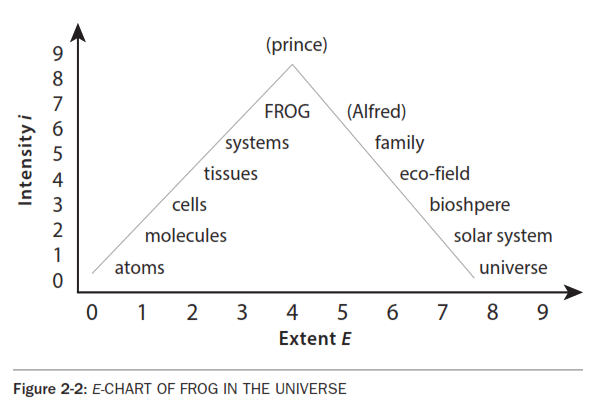
Let's consider this chart more carefully, since using E charts is so basic and helpful in analyzing more complex systems as we proceed. Notice that physiological 'systems' are placed above 'tissues' because they have more integration, i. Systems integrate their tissues. Also, they are farther to the right because they have more molecules, E. Similarly, Alfred's family has more i than his eco-field, though his eco-field has more E.
Objective Value, OV and Objective Love
Value is inherent in process itself. Objectively, value is what a system does. The human mind tends to deny that dynamic, by building its model of memories that is of necessity fixated and static, FF and TT, that separates reality from its inherent value. We are obliged to struggle to reconnect them.
Our language fixates things as nouns, then must add action with verbs. This static quality of mind contrasts with real system's dynamic Life-Of-its-Own, LOO. Within its context of infinite relatedness, each organism is inherently valuating, doing what it likes to do.
Let's summarize common ideas of objective values, the dynamic process of all systems:
- SURVIVAL is the Drive to Survive, DS, the continuity of the self, maintaining its place on the E chart. The rock resists erosion, the human resists death. Humans seem very good at DS, so far, because they seem most adaptive, maybe.
- PARTICIPATION in the total process of reality is i-integration, keeping in harmony up and down the i scale, like the jellyfish participating in the ecosystem, and the human consuming bread and wine and loving reality. Think of participation as raising some of the infinite integrations that embrace the universe to a higher level of intensity, toward behavior, even to consciousness. Think of participation as the dynamic often referred to as love. In this model, objective love us usually not subjectively experienced.
- GROWTH is combining with or engulfing other processes. For example, fish eating algae to grow and breed, or big fish eating little fish, represented by a move to the right on the E scale. Growth is the consumption of lesser systems to support the more complex and valuable system, a universal holy communion.
- EVOLUTION up the Ei, value scale, is the increase in complexity of life and culture, essentially organic growth.
These components, rather randomly chosen as they are, are meant to enhance the image of process, and must be repeated only because the mind tends to trivialize and fixate.
Subjective value is discussed, objectively of course, in the Chapter 3, PSYCHOLOGY. Here we refer to the objectivist striving to dissociate the idea of value from personal life, DIPL, p.3. Without DIPL, we are left wallowing in how we feel about something. For the serious work of human ecology and culture design, we need not be trapped in the accidents of our personal psychohistory.
Thus, value is the process itself. That's why we call it an "Evaluation chart" instead of a "process chart" - to emphasize this inherent dynamic. It is the machinery of the mind that separates reality's process from its value.
Math-like charts may be fun for many, but not for everyone. Charts, like the above E CHART OF EVOLUTION with viruses at the bottom and woman at the top, are intuitively obvious. While using such simple symbols may appear to be artificial science, the scheme is intended to encourage a quantitative mental models. It may be easy to estimate the grains of sand on the beach using a bit of arithmetic, but it is harder to compare the amount of genetic information in the genes of living things, and even more difficult to quantify the amount of interpersonal communication in a culture.
The point is, there is always something to measure. If we want to get serious, we don't just mess with words and logic, we get to the business of describing reality as a scientist does, except that we go further and look at the whole scene, not just the specialty.
Quantifying Objective Value: OV = E x i
Evaluation, then, can be described as complexity, the product of E and i, or V = E x i. The value line, from the E CHART OF EVOLUTION, goes from low Ei to high Ei, low-left to up-right. Similarly, on Fig. 2-2, E CHART OF FROG IN THE UNIVERSE, the subsystems of the frog increase in complexity, all supporting the integrity of Alfred - unless something breaks down. Notice that Alfred at 5,6 has the highest i and E of his component parts, down-left - including the bug he just ate, moving it from his ecofield at 6,4 to his stomach at 4,5.
On Alfred's chart, down right, he is supported by his family, his field, his ecosystem and the entire universe. These systems are really part of the greater-Alfred, more than just part of his support system as Alfred-the-thing. They are part of Alfred himself. Alfred, being a Buddhist frog, knows this. Also, the supporting systems all have the same value since they are the same greater Alfred. This line, the Ei of Alfred, might be called the ISO-VALUE LINE, or the same-value line: Ei = Alfred = constant, c.
Any system has its isovalue line, Ei = c, as on the next chart, Fig. 2-3. This isovalue line, slopes downward to the right. The value is constant at c: Vc = Ei, as long as Alfred lives. The isovalue lines are like the lines on a relief map in which the altitudes are the same, or on a weather map where the isobar lines indicate the pressure is the same, or on an isothermal map where the temperatures are the same.
Reviewing Alfred's plight: if Alfred's pond looses its Ei by drying and becoming a desert, it will have little value for Alfred, and he will die too. Similarly, if Alfred is taken out of his pond and put in a pet shop, he will likely die before he is sold. If all the frogs are so dispatched, by desertification, ozone depletion, or commercialization, the Ei of the entire system degrades. Ecology studies it, culture design fixes it.
It may not be easy to keep dynamic images in mind. Alfred is apt to become a mere icon because of the nature of our minds, but this inevitable trivialization and fixation by FF and TT can be alleviated with images based on such a process model.
Next, let's generalize the E chart in Fig 2-3, so that we may move toward using it to analyze all other complex systems.
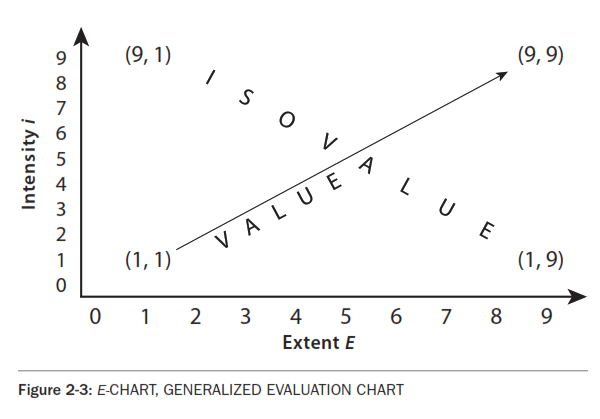
The value line, low-left to up-right, traces a sequence of systems, each more complex, therefore more valuable, than the last, such as the evolution of life, (phylogeny), or the development of a person, (ontogeny), or even the growth of social, political, economic, and cultural organisms.
Expressed in simple algebraic terms, this inherent value is the product of the number of subsystems, E, and the degree of their organization, i: Value, V = Exi. Even though we don't or can't measure i and E, imagining them as quantities alleviates RID and encourages more objective images. For example, Ei of life is its complexity and diversity. Ei of a person might be empathy, intelligence and skill. The Ei of society could be its development (Chapter 4). The Ei of politics ... surely there's something to measure.
We might even stretch this poetry of algebra to express the line of isovalue, Vi=E/i=constant. Alfred is not just a lonely frog, but a component of the universe. Without the support of the ecosystem including a supply of bugs and protection from the Sun's ultra-violet radiation, Alfred would break down. Thus if Alfred's Vi becomes much less than some constant, if this line of his eco-support system becomes too steep, he will die prematurely. For example if the i of his pond dries up making a steep decline at the eco-field level, Alfred will die. He will fall off the i cliff from lack of ecosystem support. If conditions continue to degrade his entire species is endangered. Sketch this for practice.
Since Alfred is one with the universe, as we all are, the loss of ecosystem or socio-cultural support diminishes not only the being in question, but the Total Process, TP, of the entire universe. Alfred's bell tolls for us all.
These quasi-algebraic expressions are helpful but not crucial for applying our process model to human ecology and culture design. As we use the process model to analyze more complex systems - such as man, society and economy - it will become more familiar and intuitively clear.
Notice that the direction of positive value, more integration, i and more extent, E, is toward the upper right, 9,9. The lower right 9,1 reflects the same number of subprocesses, E, but is not so highly organized. The bottom left 1,1 represents a process with fewer sub units and less integration. Finally, 1,9, represents a high integration of fewer subprocesses. Slanted line from 1,9 to 9,1 represents a trade off of i for E, but with the same net value, isovalue, Ei = c. The slope, commonly called "m", is m = -1.
The positive slanted line represents a gain in value both by i and E. Objective value has the slope, m = +1.
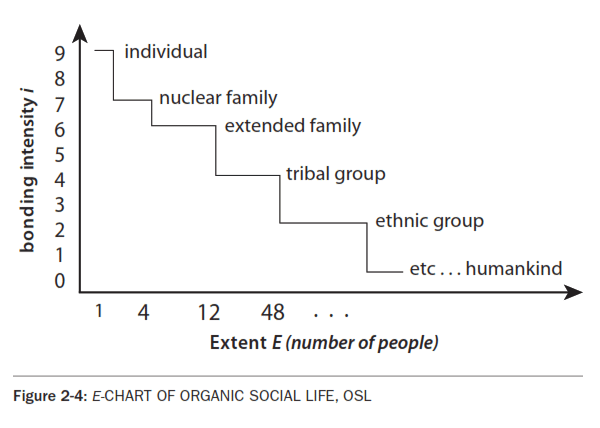
In order to derive the DIAGNOSTIC, D CHARTS that follow, let's look more closely at the E charts. In Fig. 2-4, E CHART of ORGANIC SOCIAL LIFE, OSL, the highest i unit is the individual, supported down the isovalue line by parent or mate in nuclear family, then extended family, clan, tribe, ethnic group, etc., finally to all mankind. Let's omit the meat to the left, the down-left components of the individual. Notice in each step the integration, i, (the bonding) is less, but the number of sub-units, E (that's people), is greater. Simply, we are more attached to those closest to us in space, time and relationship. Keeping DIPL, this simple statement is an objective generalization, it does not refer to our subjective experiences or personal positions.
Notice that we do not chart substructure, a simplifying false focus, FF. Modern scientists strive to elaborate the image of the subsystems in animals and plants. Theories of complexity compare the substructure of a branching tree with the substructure of the circulatory and skeletal systems of animals, etc. Let's look only at the gross E and i without regard to the very important substructures, fractals, feedback loops, and other mechanisms of complex systems.
In this example, notice the curve can be more or less bumpy: The i step at "individual" represents the i discontinuity between the individual and the family. This individualism, or i Discontinuity, iD, is a favorite variable among different people and different cultures. In New York City, about half of the households have only one person - an iD cliff. This conflict between the individual and society is the grist of much literature, drama and art. In addition, this iD between the individual and her support system changes with time, depending on how the kids wake up that morning.
iD Is Where the Action Is
On any E chart, the greater the vertical jump, the greater the action. This i Discontinuity, iD, is the action front of all systems, a crucial point in process theory: The skin of a baby, the relations between people, the surface of the sun, the seashore, the electron cloud of the atom. Imagine examples to illustrate this image: The seashore is the dynamic interface of solid, liquid and gas. Then imagine a tree as the integrator of this solid, liquid and gas. Perhaps we walk in the woods to participate symbolically in this ubiquitous principle, or, more subjectively, to expand our consciousness in the worship of nature, as the ecopsychologists explain.
Minor System
In any complex system, one subsystem has more i than the others, and this subsystem is the integrating system of the whole. Referring back to Fig. 2-1: E CHART OF EVOLUTION, p.12, notice that the individual is the acme of the universe, a microcosm of the total process, the highest Ei. However, the individual would not exist without the support of the whole, and depends for survival on the (objective) love of the family, the health of the ecosystem, the temperature of the sun, etc.
But the controlling Minor System, MS, the individual, has a Life Of its Own, LOO, and tends to dissociate itself from its own support system by increasing its own i! This term 'controlling' implies a power relationship, as in an adversarial culture like ours. We might have used another term, perhaps 'managing' or 'organizing' or 'coordinating'. Such is the human condition, the dynamic of mind, society, and all of reality, as we shall see.
Dissociation of the Minor System, DMS
Let's call this highest i process a MINOR SYSTEM, MS. The minor system is the coordinating and controlling part of any major system. The other supporting parts we will call "subsystems".
Examples of minor systems in their corresponding systems include: the individual in society, the government in polity, the leader in the government, the elite in society, the monopoly in the market, the ego in the Greater Self, GS, the consciousness in the brain, the clergy and laity - even this Process Model in one's broader and deeper perception and world-view.
Dissociation is the problem in all complex systems. Let's call this conflict between the minor system and its supporting sub-systems, the Dissociation of the Minor System, DMS. It's so basic in the analysis of complex systems that it requires a special chart, a DIAGNOSTIC or D CHART. D charts are derived from the i bumps the i discontinuities on E charts. D charts measure the DMS, the degree of i dissociation between the organizing minor system and its supporting sub-systems.
Pathology and Therapy of Systems
In social life, the D charts would measure the degree of dissociation, iD, of the individual from the supporting subsystems of family and culture. The Vertical integration, Vi of the minor system with its supporting subsystems is the therapy for all complex systems. Vertical integration is a most basic strategy for culture design, as outlined in later chapters.
Of course, modern systems theory has much more to say about the patterns of systems. For example, common ants and bees seem to coordinate with very little MS control. Scientists copy their design in little robots who coordinate without direction. [See SWARM SMARTS by Eric Bonabeau and Guy Theraulaz]
The E chart below, Fig 2-5, represents the individual who lives alone, with only thin relationships with family, perhaps a smattering of quasi-family relationships at work, and a few friends and acquaintances.
In order to describe this i dissociated life style we are obliged to give it a name. Let's call it "abstract" life, from the Latin origins of that word, "dragged away". He is "dragged away" from a healthy social support system and lives an Abstract Social Life, ASL. (Dr. Laura *Nader, in her lecture THE *TYRANNY OF PERSONAL FREEDOM, uses the term "constructed" rather than our "abstract", perhaps stressing iD's human elements and origins.)
The E chart on the right, Fig 2-6, represents a less alienated person, part of a nuclear family at the second step, a network of extended family and clan at the third step, then a number of quasi-tribal relationships, and so on. Let's call this i integrated mode Organic Social Life, OSL. (The term "Organic Social Life" is used by famous jurist Oliver Wendel *Holmes and is reproduced on the frieze of Boalt Hall, of the Law School of the University of California at Berkeley.) This OSL socio-cultural support system has more objective health than the ASL life of the alienated person on the left E chart, fig. 2-5. Observe our culture's leap away from extended family into alienation, from the right chart to the left. This compulsion to the abstract life, CAL, operates objectively. It can be measured objectively by measuring how people interact and group. Subjectively it is experienced through people's emotional positions and rationalizations, as we shall see in Chapters 3 and 4.
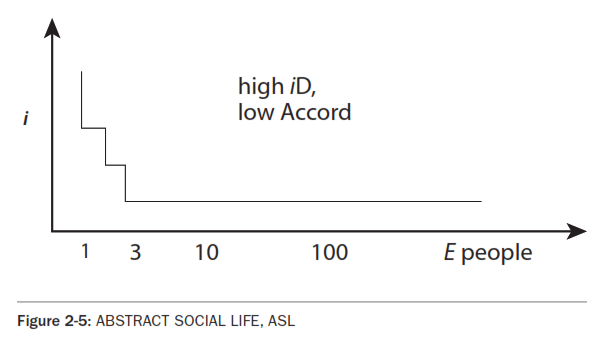
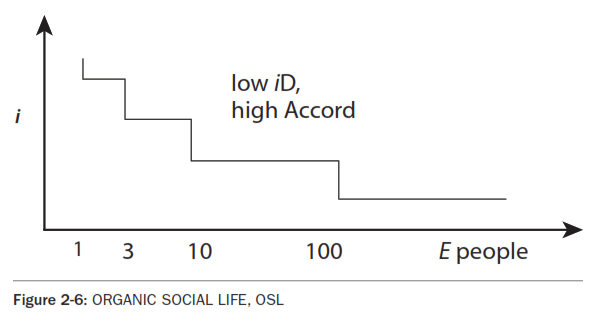
Compare the slant of these ABSTRACT vs ORGANIC E CHARTS. See that the, DIAGNOSIS, D CHART, is derived from EVALUATION, E CHARTS. The left side of the D CHART, Fig. 2-7 represents the dissociated condition of Abstract Social Life shown on the left E CHART, Fig. 2-5. The right side of this D CHART represents the right ORGANIC, or ACCORD E CHART, Fig. 2-6.
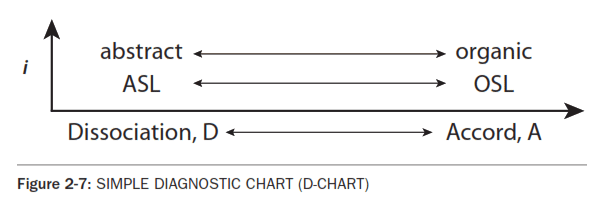
Reverting from humans to frogs for a moment, this left abstract condition represents Alfred living in the pet store, or worse yet in some kid's terrarium. The right side represents Alfred supported by all his friends in his own pond.
This GENERALIZED DIAGNOSTIC, D chart below in its more complete form represents the dynamic of pathology:
| ABSTRACT, | ACCORD, | |
| iD Dissociation, | i Integration, | |
| on the left: | on the right: |
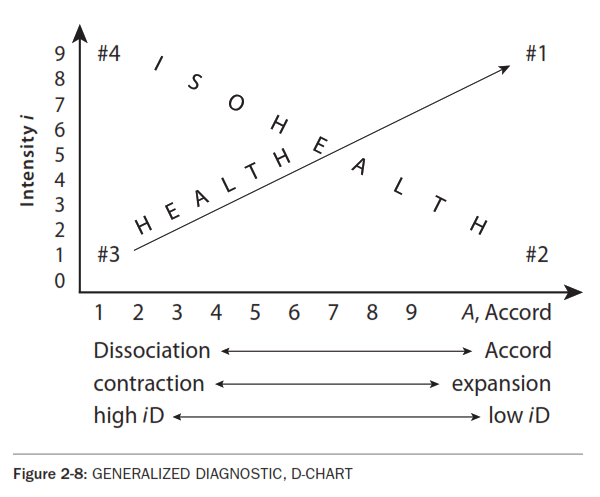
Notice the movement up and to the right represents HEALTH, H = Ai. The slant down to the right is called the iso-health line, Hc = A/i = c, constant. Simply put, increasing the harmony and intensity is up the iA Health line. Whereas going up left on the Isohealth line represents being more intense, individualistic, isolated. In the following chapters these principles apply to complex systems such as human life, mental states, political processes, economic activity, and even cultural and religious matters.
Playing by Numbers
To develop a useful objectivist view, we must return our attention to the actual processes that we are describing. Using the charts and referring to the numbers is helpful because it is more quantitative and often easier and quicker than verbal description.
Unfortunately, because of the RIDly rationalist - idealist influence on our thinking, and perhaps a basic predisposition of mind, people often use numbers as if they were words, and, likewise, expect them to have defined, precise and certain meanings. Recent brain studies disclose this contrast.
To some people, numbers, and terms like "objectivity", may falsely connote certainty or absolutism. Objectivists, like scientists, acknowledge the limited description of all quantities and the inaccuracy of all statements. Although the numbers on the charts may do little to loosen the RIDs straitjacket, let's use the numbers anyway, while keeping the RIDly impulse in check.
Notice that the right-hand side of the DIAGNOSIS D CHART, Fig. 2-8, represents the high A: call it the more in Accord, more organic, or more harmonious side. The left side is the more abstract or i Dissociated side, higher D, lower A. Because of the i Dissociation, the minor system is in greater conflict with the major system, more adversarial. It uses more power than harmony in its role as the organizer. The left scale represents i, the intensity or integration of the system, about the same as on the E chart.
Let's view the D Chart in terms of our friend Alfred. The upper right (9,9), at #1, has the highest intensity, i, and the most accord; therefore it is most vigorous and most healthy organism. This might represent Alfred as happy, healthy and vigorous. Below that, (9,1), at #2, represents a harmonious but less vigorous process. This would be Alfred, harmonious but inactive. Then (1,1), at #3, represents a system of low intensity as well as severe i dissociation, with low integration but high internal conflict. This would represent Alfred as ill and depressed, or dead in the garbage. Finally (1,9), at #4, represents a system which is very vigorous and intense, but also highly conflicted and power-oriented. This would be Alfred, vigorous but a big pain to all concerned, fighting with himself, bullying his fellow frogs, and ruining his ecosystem.
Payoff
Since iD is where the action is, the payoff for this i dissociation is an increase in intensity, but at the price of the 'contraction' of the system, and a threat to its own support mechanisms. The problem of the Dissociated Minor System, DMS, operates both internally and externally. This i dissociation strains the external support systems of social and economic support, but also strains the internal systems, ordinary physical health.
Why would Alfred, or anyone, take this route? Is he forced into it by larger systems? Is he catching a bigger gnat during a draught, fighting for a mate or a larger territory, trying to arouse himself from depression or enjoying the excitement of conflict? In Chapter 3, PSYCHOLOGY, we shall consider humans instead of frogs.
Dynamic DMS
In general, the minor system has the role and responsibility of maintaining the greater system - whether MS is less or more dissociated from its supporting subsystems, GS. If the iE value of the minor system declines, the subsystems take over, to the detriment of the total system.
Subsystems are not only supportive and cooperative, they are also adversarial and competitive. For example, after a meal, digestion competes with the brain. After logging, the rejuvenation of the forest competes with cattle grazing. Keep this dynamic in mind. It's a dynamic that the 'abstract' mind tries to deny.
Pathologies
Imagine these examples of the failure of the minor system to organize its major system: In the individual, the ego loses its integrative function and the individual breaks down. The economy falls into depression from lack of monetary controls. The classroom explodes into chaos when the teacher leaves the room. The Russian economy collapses when the government becomes too weak to collect taxes or control the cleptocracy. The church loses membership when the clergy becomes corrupt.
This dissociation of the minor system, in every system, is a basic issue in human ecology and culture design. DMS includes its failure to organize, or its dissociation its major system, or both. The more dissociated the system, the more intense it is, but also the more rigid and fragile. The more harmonious and organic the system, the more serene it may be, and also the more versatile and adjustable. Minor system management is an endless problem, essential to the Ei maintenance and growth of any complex system, as we shall outline in detail in the following chapters.
Contraction vs Expansion
The D Charts, Fig. 2-7 & 8, analyze systems moving between their more abstract and more organic modes. For example, in human consciousness the abstract mode is intense, narrowly focused and rational - an adrenaline high. In the more organic mode, consciousness is more diffused, less intense, more intuitive - a serotonin high. On the D chart, this dynamic is represented by shifts from the more abstract mode on the left, to the more organic on the right. Notice the minor system is usually more intense on the abstract side, less intense on the organic side.
Contraction Expansion Dynamic, CED
From this point of view oscillation is left and right. But from the minor system view point, this contraction - expansion dynamic is not simply left and right, but rather from the up-left to the down-right, on the iso-health line as in Fig. 2-8. The system as a whole contracts in support of the minor system, but then expands, as if to rest and heal itself, as in waking and sleeping. 2-8. Presumably the total system is just as healthy awake as asleep, with the Ei product equal for the two states: when waking up, the i measure increases while the E measure decreases. Examples of this dynamic from assorted fields might also include: manic - depressed, authoritarian - democratic, elitist - egalitarian, etc., as we shall see.
Let's call this oscillation up and down the isohealth line the CONTRACTION EXPANSION DYNAMIC, CED. Notice that CED slants downward, perpendicular to the value and health lines that slant upwards as in evolution on E charts and healing on D charts.
For an illustration of this CED parameter and how it manifests, see Ripoff-Service, [GOLDEN MEAN]
Example from Agriculture
A current concern of agriculturalists exemplifies this abstract vs. organic Ai parameter. They talk of redirecting today's abstract commercial-industrial farming towards organic farming. Abstract farming is out of harmony with the ecosystem that supports it. In contrast, organic farming is more in accord with the supporting ecosystem.
Common abstract farming looks narrowly at short term profits, whereas the organic approach takes more long term ecological view. Abstract farming uses more gasoline, chemical fertilizer and insecticides. Organic farming uses "low tillage", more compost and organic pesticide management. Obviously, organic agriculture is more sustainable, since abstract farming looses top soil, uses more fossil fuel, etc.
Some government crop subsidy programs have encouraged abstract farming. Earlier acreage limitations tempted farmers to douse the allowed acreage in order to maximize profits, incidentally raising costs and increasing ecological damage. Another travesty occurs when common business accounting excludes "external costs" or "externalities", such as the gradual loss of ecological resources such as ground water and top soil. These factors can be diagnosed on the D chart. We can thank both OPEC and the *AQUARIAN CONSPIRACY for a healing influence on agriculture, and on culture. But we have miles to go before we rest.
The Cubans are reverting to organic agriculture on a grand scale. With the dissolution of the Soviet Union, Cuba's energy and machinery costs have risen even higher than they would have without the influence of the United States embargo, OPEC, and the oil trans-nationals. See *WORLD WATCH INSTITUTE and *NACLA periodicals for up-to-date information.
Chart analysis can show that organic farming is objectively better than abstract farming. It is better on an E chart measuring objective profit, long-term sustainability and often, productivity. It's better on a D chart measuring ecological health. The analysis works with both natural ecology and with human ecology.
Abstract vs Organic, in Agriculture & Human Culture
Let's imagine two quite different but obviously related systems: agriculture and human culture. Then let's put them in the same table for comparison.
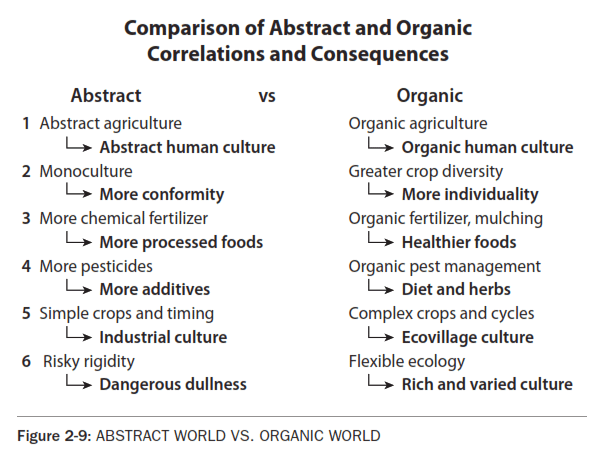
Contraction, Causes and Cures
Contractions are not all bad. The gift of consciousness itself is a contraction. It has even been called a pathology by philosopher Unamuno. Don't we all feel that way sometimes? But we prefer to call it a gift, and enjoy indulging it occasionally. Consciousness evolved as neural processing expanded its vast mental model ultimately to focus on a train of thought.
Let's consider that contractions are caused by stresses or traumas. Imagine the following great dynamics as contractions: The universe seemingly started with the big bang, contracting reality out of nothing. Stars contract out of the firmament. The shock of human consciousness is poetically portrayed as beginning with the fruit of the tree of knowledge, a contractive awareness alienating Adam and Eve from the paradise of organic unity. On an E chart these contractions are up and to the right, but on a D chart they are up and to the left. Birth is a great and tragic separation from the ocean of evolutionary life. Dissociations, inherent in the ebb and flow of contraction and expansion, tend to heal in their own way, especially if they are nurtured in an organic system.
Fragility of Contraction, FOC
The greater the contraction, the greater the fragility. FOC is a manifestation of the dissociation of the minor system, DMS. Since contracted minor systems are in greater conflict with their supporting sub-systems, they are in a precarious position. To illustrate and experience this: Remain intensely conscious for several days without sleep. You will observe the fragility of your ego system as it tries to intensify itself without the down-time organic integration of sleep, schizophrenic symptoms.
A fragile minor system does not go gently. It's modest demise is the fantasy of a rationalist mind denying the dynamic of systems. Instead it often escalates its own intensity, up left on the Ei chart. As detailed in later chapters, this intensification includes the contracted mind escalating to bullying and schizophrenia, the contracted government escalating to fascism, the contracted economy escalating.... Call this important process, the Dynamic of Escalating Contraction, DEC. Eventually the whole system gets decked, DECed. The Roman empire lasted only half a millennium, but remnants persist as a fragile religion.
Humankind's intelligent attention is increasingly important in maintaining *LIFE ON EARTH. It is easy to destroy a forest ecosystem, but almost impossible to build one. "... only God can make a tree. Good intentions are not yet good enough when contracted cultures destroy complex systems. The remaining rain forests, rapidly being ruined, may never recover. This drastic devolution of our ecosystem contributes to the threatening devolution of humanity. It is more efficient to stop the destruction of ecosystems than to try to rebuild after the damage is done. "That intervention is best that intervenes least." The adage that science and technology can fix anything they break is a diabolically distorted denial. Reforestation is welcome, but let's tell the whole truth: Reforestation is often phony because its purpose is not to rebuild a forest ecosystem but to build a more profitable tree farm. Explain this as a difference in Ei as measured by the number of species or any other ecological measure. Be aware that the tree farm as a monoculture is more vulnerable to disease and exhibits the fragility of contraction. It's a FOCed forest.
Similarly modern abstract culture can degrade human life and its supporting ecosystem, as explained by human ecologist Paul *Shepard. To reverse this terrible trend requires the responsible application of human intelligence. We cannot expect the hand of God or Gaia to take care of what man degrades. Progress needs both evolution, Ei, and healing, Ai.
Human Ecology and Culture Design, the Task
The illustration of abstract versus organic farming offers a preview of the principles of human ecology and culture design.
Like natural ecology, human ecology demands a broader view. The scientist, or objectivist metascientist, is obliged to look at the whole picture and resist the temptation to demand that everything be "perfectly clear". Human ecology is even more complex than natural ecology, but the demands are similar. "We must look forward to great tomorrows."
Summary of Systems
In the summary of systems below, the left column is the GREATER SYSTEM, to the right is its controlling MINOR SYSTEM. The E CHART measures the value from left to right. The D CHART measures its health from DISSOCIATION to ACCORD. Notice these are not dichotomies but parameters, measures to compare systems and subsystems, ala *Kosco.
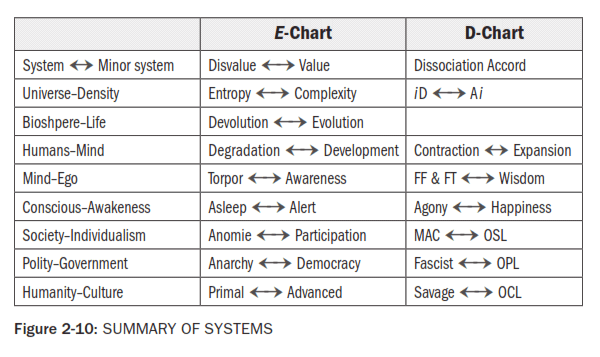
Conclusion: A Simple Theory of Complex Systems
The universe is one gigantic system. It encompasses all subsystems, including you and me. By the nature of its conscious process, the mind thinks of one thing at a time; therefore, we must slice up reality, then build a mental model of it.
From a scientific or objectivist point of view, reality goes on regardless of our experience. Our model of reality can never match reality itself. Yet, it often seems that thinking makes it go - but not so. In spite of this profound mismatch of mental model and reality, the blessed consciousness is our greatest gift.
Unfortunately, reality is not made of words. The task is not to define but rather to describe what's occurring. The more ground the scientists cover in these matters, the more frontiers loom ahead. In spite of the human intellect's compulsive reductionism, great progress is being made. From the Age of Aquarius to the new World Order images of the future proliferate inviting exploration with new ways of thinking and new tools.
Because of this profound mismatch of reality and mind, we can never really prove anything about reality itself, though humankind has gradually improved is ability to describe and predict what's going on. Certainty is something the mind seems to want, but it's all in the head. A nice feeling perhaps, but certainty is a lie and a trap, of that we can be certain. Fortunately, our minds are better at intuiting than they are at being sure; therefore, be relieved of the burden of certainty and proof. Instead, let's coordinate our efforts to describe and share what's happening as best we can.
All the various subsystems that we might slice from reality can be analyzed according to their intensity, i, and their extent, E. For example, the universe can be sliced up into stars which are a mass of matter, E, clumped by a certain intensity, i. The E measures the amount of matter, such as the number of particles or grams of material. The i measures the degree of relationship or process between the parts of E, such as their gravity and mutual radiation. Objects exist only at a defined level of i.
The most complicated system we know about is the human being. In humans, E can refer to the amount of information and i the integration of the person. We could describe the person by the cells and tissues, or by the sugar and spice. But any image is inherently oversimplified; any method is burdened by the mind's inherent reductionism. We must always struggle for a more holistic view, and always acknowledge that there is more going on than we can know.
Like any complex system, the human has a managing minor system, the brain, that organizes the other subsystems. For example, the brain seems to organize circulation and respiration. This organizing subsystem gets a special name, the MINOR SYSTEM, MS. In human physiology the MS is the nervous system. Within the brain's mind, the minor system is the consciousness or ego. In society, the organizing system is the polity. In politics, the minor system is the government, and so on for whichever complex system comes to mind: a farm, a classroom, a TV network, ....
In every complex system the minor system takes on a life of its own, LOO, often in dynamic conflict with the greater system and its own supporting subsystems. This basic dynamic is called the "Dissociation of the Minor System, DMS". This DMS is a matter of degree: On the right, ACCORD, side of the D chart, every function is integrated into some complex hierarchy. As represented on E charts, this most highly integrated system organizes right down the i scale to the next level of integration, then the next, and so on down to the basic elements. This graduated structure is called the organic or expanded mode of process. On the left, DISSOCIATION, side of the D chart, this harmonious cooperation is degraded by DMS. The minor system, asserting a life of its own, becomes dissociated from its own supporting subsystems. Even though this organizing MS might benefit in intensity by this mode, it does so at the expense of the whole and at risk to its own sustenance: the ego in the mind, the mind in the body, the father and the family, the foreman and the crew, the farmer and the ecosystem, the government and the people, the rich and the poor, homo sapiens and the zoasphere, the earthlings and the universe.
With this image of reality in mind, and correcting for the distortions inherent in the operation of consciousness, let's apply this process theory to the evaluation and diagnosis of all complex systems: in psychology, sociology, politics, economics, ideology, education and religion. Let's describe what the compulsion to the abstract life portends for the future of mankind. Then let's discuss what can be done to alleviate and reform our omnicidal culture. That is the task of human ecology and culture design.
Like any scientific theory, this process theory is neither a belief nor an opinion. It is an objectivist image of how reality is built, how mental process compares to other complex processes, and how it is possible to use the mind to understand what's happening, and to alleviate the dissociations inherent in the human condition.
| < Chapter 1: REALITY AND SCIENCE, What's So | Chapters Essays | Chapter 3: PSYCHOLOGY, Mental Mechanisms > |
| Copyright © 2024 Earl Williamson. All rights reserved. | Feedback | Last updated Monday, April 9, 2018 05:50 UTC |